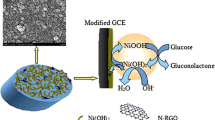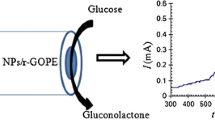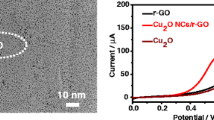Abstract
A sensitive amperometric method is reported for the determination of lactate. A platinum electrode was modified with a composite prepared from reduced graphene oxide (rGO), carbon nanotubes (CNTs) and gold nanoparticles. The composite was synthesized by the in-situ reduction of gold(III) ions on the GO-CNT hybrid. Triple composite components showed synergistic effects on the enzyme loading, electrocatalytic activity and electron transfer between receptor and electrode surface. The amperometric lactate sensor was obtained by immobilization of lactate oxidase (LOx) on the modified electrode. LOx catalyzes the conversion of lactate into pyruvate and hydrogen peroxide. The generated hydrogen peroxide is simultaneously involved in the oxidation reaction, which is associated with the electron production. These electrons act as amperometric signal generators. At the low potential of 0.2 V, the nanobiosensor shows a relatively wide linear analytical range (i.e., 0.05–100 mM of lactate) with high electrochemical sensitivity (35.3 μA mM−1 cm−2) and limit of detection of 2.3 μM. The sensor is stable, repeatable and reproducible. It is a highly sensitive tool for the detection of lactate in biological samples under both normoxic and hypoxic conditions.

Schematic representation of an electrochemical biosensor for sensitive detection of lactate in biological and food samples based on reduced graphene oxide-carbon nanotube-gold nanocomposite, as a surface modifier, and lactate oxidase, as a bioreceptor.



Similar content being viewed by others
References
Barar J, Omidi Y (2013) Dysregulated pH in tumor microenvironment checkmates cancer therapy. BioImpacts. 3(4):149–162. https://doi.org/10.5681/bi.2013.036
Katz A, Sahlin K (1987) Effect of decreased oxygen availability on NADH and lactate contents in human skeletal muscle during exercise. Acta Physiol Scand 131(1):119–127. https://doi.org/10.1111/j.1748-1716.1987.tb08213.x
Lum JJ, Bui T, Gruber M, Gordan JD, DeBerardinis RJ, Covello KL et al (2007) The transcription factor HIF-1α plays a critical role in the growth factor-dependent regulation of both aerobic and anaerobic glycolysis. Genes Dev 21(9):1037–1049. https://doi.org/10.1101/gad.1529107
Annibaldi A, Widmann C (2010) Glucose metabolism in cancer cells. Curr Opin Clin Nutr Metab Care 13(4):466–470. https://doi.org/10.1097/MCO.0b013e32833a5577
Bartrons R, Caro J (2007) Hypoxia, glucose metabolism and the Warburg’s effect. J Bioenerg Biomembr 39(3):223–229. https://doi.org/10.1007/s10863-007-9080-3
Goodwin ML, Gladden LB, Nijsten MW, Jones KB (2015) Lactate and cancer: revisiting the Warburg effect in an era of lactate shuttling. Frontiers Nutr 1:1–3. https://doi.org/10.3389/fnut.2014.00027
Rathee K, Dhull V, Dhull R, Singh S (2016) Biosensors based on electrochemical lactate detection: a comprehensive review. Biochem Biophys Rep 5:35–54. https://doi.org/10.1016/j.bbrep.2015.11.010
Pal R, Parker D, Costello LC (2009) A europium luminescence assay of lactate and citrate in biological fluids. Org Biomol Chem 7(8):1525–1528. https://doi.org/10.1039/b901251f
Sartain FK, Yang X, Lowe CR (2006) Holographic lactate sensor. Anal Chem 78(16):5664–5670. https://doi.org/10.1021/ac060416g
Takahashi S, Kurosawa S (2008) Anzai Ji. Electrochemical determination of L-lactate using Phenylboronic acid monolayer-modified electrodes. Electroanalysis. 20(7):816–818. https://doi.org/10.1002/elan.200704097
Pereira AC, Aguiar MR, Kisner A, Macedo DV, Kubota LT (2007) Amperometric biosensor for lactate based on lactate dehydrogenase and Meldola blue coimmobilized on multi-wall carbon-nanotube. Sensors Actuators B Chem 124(1):269–276. https://doi.org/10.1016/j.snb.2006.12.042
Rahman M, Shiddiky MJ, Rahman MA, Shim Y-B (2009) A lactate biosensor based on lactate dehydrogenase/nictotinamide adenine dinucleotide (oxidized form) immobilized on a conducting polymer/multiwall carbon nanotube composite film. Anal Biochem 384(1):159–165. https://doi.org/10.1016/j.ab.2008.09.030
Sirkar K, Revzin A, Pishko MV (2000) Glucose and lactate biosensors based on redox polymer/oxidoreductase nanocomposite thin films. Anal Chem 72(13):2930–2936. https://doi.org/10.1021/ac991041k
Wang Y, Bao Y, Lou L, Li J, Du W, Zhu Z et al (2010) A novel L-lactate sensor based on enzyme electrode modified with ZnO nanoparticles and multiwall carbon nanotubes. J Electroanal Chem:33–37. https://doi.org/10.1016/j.jelechem.2011.06.024
Lei Y, Luo N, Yan X, Zhao Y, Zhang G, Zhang Y (2012) A highly sensitive electrochemical biosensor based on zinc oxide nanotetrapods for L-lactic acid detection. Nanoscale. 4(11):3438–3443. https://doi.org/10.1039/C2NR30334E
Ibupoto ZH, Shah SMUA, Khun K, Willander M (2012) Electrochemical L-lactic acid sensor based on immobilized ZnO nanorods with lactate oxidase. Sensors. 12(3):2456–2466. https://doi.org/10.3390/s120302456
Zhao Y, Li W, Pan L, Zhai D, Wang Y, Li L et al (2016) ZnO-nanorods/graphene heterostructure: a direct electron transfer glucose biosensor. Sci Rep 6:32327. https://doi.org/10.1038/srep32327
Zhang W, Li X, Zou R, Wu H, Shi H, Yu S et al (2015) Multifunctional glucose biosensors from Fe3O4 nanoparticles modified chitosan/graphene nanocomposites. Sci Rep 5:11129. https://doi.org/10.1038/srep32327
Song J, Xu L, Xing R, Li Q, Zhou C, Liu D et al (2014) Synthesis of Au/graphene oxide composites for selective and sensitive electrochemical detection of ascorbic acid. Sci Rep 4:7515. https://doi.org/10.1038/srep07515
Rakhi R, Nayak P, Xia C, Alshareef HN (2016) Novel amperometric glucose biosensor based on MXene nanocomposite. Sci Rep 6:36422. https://doi.org/10.1038/srep32327
Hossain MF, Park JY (2016) Plain to point network reduced graphene oxide-activated carbon composites decorated with platinum nanoparticles for urine glucose detection. Sci Rep 6:21009. https://doi.org/10.1038/srep21009
Wang J (2005) Carbon-nanotube based electrochemical biosensors: a review. Electroanalysis. 17(1):7–14. https://doi.org/10.1002/elan.200403113
Nikoleli G-P, Karapetis S, Bratakou S, Nikolelis DP, Tzamtzis N, Psychoyios VN (2016) Graphene-based electrochemical biosensors: new trends and applications. Intelligent Nanomat 2:427–448. https://doi.org/10.1002/9781119242628.ch13
Marcano DC, Kosynkin DV, Berlin JM, Sinitskii A, Sun Z, Slesarev A et al (2010) Improved synthesis of graphene oxide. ACS Nano 4(8):4806–4814. https://doi.org/10.1021/nn1006368
Hwa K-Y, Subramani B (2014) Synthesis of zinc oxide nanoparticles on graphene–carbon nanotube hybrid for glucose biosensor applications. Biosens Bioelectron 62:127–133. https://doi.org/10.1016/j.bios.2014.06.023
Perumal M, Nesakumar N, Velayutham D, Madasamy K, Murugavel K, Kulandaisamy AJ et al (2018) A novel electrochemical sensor based on a nickel-metal organic framework for efficient electrocatalytic oxidation and rapid detection of lactate analysis. New J Chem 42:11839–11846. https://doi.org/10.1039/c8nj02118j
Abrar MA, Dong Y, Lee PK, Kim WS (2016) Bendable electro-chemical lactate sensor printed with silver nano-particles. Sci Rep 6:30565. https://doi.org/10.1038/srep30565
Hernández-Ibáñez N, García-Cruz L, Montiel V, Foster CW, Banks CE, Iniesta J (2016) Electrochemical lactate biosensor based upon chitosan/carbon nanotubes modified screen-printed graphite electrodes for the determination of lactate in embryonic cell cultures. Biosens Bioelectron 77:1168–1174. https://doi.org/10.1016/j.bios.2015.11.005
Goran JM, Lyon JL, Stevenson KJ (2011) Amperometric detection of l-lactate using nitrogen-doped carbon nanotubes modified with lactate oxidase. Anal Chem 83(21):8123–8129. https://doi.org/10.1021/ac2016272
Acknowledgments
This article is a part of a Ph.D. thesis, written by Ms. Shabnam Hashemzadeh, approved at the School of Medicine, Shahid Beheshti University of Medical Sciences, Tehran-Iran (Registration No: M 360) in collaboration with the Research Center for Pharmaceutical Nanotechnology (RCPN) at Tabriz University of Medical Sciences, Tabriz-Iran. This study was financially supported by and technically conducted at the RCPN (Grant No: 97005).
Author information
Authors and Affiliations
Corresponding authors
Ethics declarations
Conflict of interests
The authors declare no conflict of interests.
Ethical issues
This study was ethically approved by Shahid Beheshti University of Medical Sciences (Approval ID: IR.SBMU.MSP.REC.1396.753).
Additional information
Publisher’s note
Springer Nature remains neutral with regard to jurisdictional claims in published maps and institutional affiliations.
Electronic supplementary material
ESM 1
(DOCX 288 kb)
Rights and permissions
About this article
Cite this article
Hashemzadeh, S., Omidi, Y. & Rafii-Tabar, H. Amperometric lactate nanobiosensor based on reduced graphene oxide, carbon nanotube and gold nanoparticle nanocomposite. Microchim Acta 186, 680 (2019). https://doi.org/10.1007/s00604-019-3791-0
Received:
Accepted:
Published:
DOI: https://doi.org/10.1007/s00604-019-3791-0




